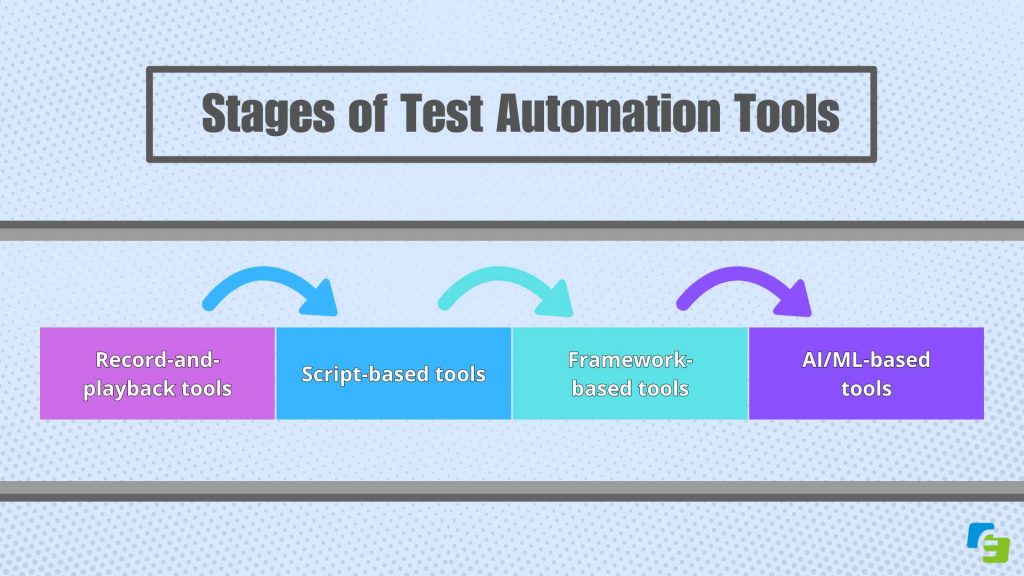Introduction
Picture this: You’re eagerly awaiting the launch of a new app, excited to explore its features and functionalities. But as soon as you download it, you encounter bugs and glitches that disrupt your experience. Frustrating, isn’t it? This scenario is all too familiar in today’s digital age, where the demand for flawless software is at an all-time high.
This is where test automation helps – the unsung hero behind the scenes, working tirelessly to ensure that your favorite apps perform seamlessly. Test automation has evolved from a mere convenience to an indispensable tool in the software development arsenal.
As the pace of innovation accelerates and customer expectations soar, the need for efficient testing processes has never been more critical. In this article, we’ll delve into the fascinating journey of test automation, tracing its evolution from humble beginnings to cutting-edge AI-driven solutions.
Join us as we uncover the power of automation in shaping the future of software testing.
What is Test Automation?
Test automation represents a paradigm shift in software testing methodologies, enabling organizations to automate repetitive testing tasks through specialized software tools. Imagine a scenario where a leading e-commerce platform is preparing for a major update to its mobile application.
Traditionally, manual testers would meticulously navigate through each feature, verifying functionality, and identifying potential bugs.
However, with test automation, this laborious process is streamlined. Utilizing automation tools like Selenium WebDriver, test scripts can be created to simulate user interactions, such as clicking buttons, entering text, and navigating through screens.
These scripts are then executed automatically, allowing for rapid and comprehensive testing across various devices and configurations.
Key Components of Test Automation Frameworks:
Test automation frameworks serve as the backbone of automated testing endeavors, providing structure, organization, and efficiency to the testing process. Understanding the key components of these frameworks is essential for maximizing their effectiveness in software development.
1. Test scripts:
At the core of any test automation framework are the test scripts, which contain instructions for performing specific test scenarios. These scripts are typically written using programming languages like Java, Python, or JavaScript, and they interact with the application under test to simulate user actions and verify expected behaviors.
2. Test data:
Test data encompasses the inputs, outputs, and conditions necessary to execute test cases effectively. This includes both valid and invalid data inputs to assess the robustness and accuracy of the application’s functionality. Proper management and manipulation of test data are critical for comprehensive test coverage and reliable test results.
3. Execution engine:
The execution engine is responsible for running the test scripts and orchestrating the testing process. It interprets the instructions provided in the test scripts, interacts with the application interface, captures test results, and generates reports. The efficiency and reliability of the execution engine significantly impact the overall speed and effectiveness of test automation.
4. Reporting mechanism:
A robust reporting mechanism is essential for capturing and communicating test results, insights, and metrics. It provides stakeholders with visibility into the quality of the software under test, highlighting areas of concern, identifying trends, and facilitating data-driven decision-making. Comprehensive reports help teams assess the impact of test automation efforts and prioritize areas for improvement.
By leveraging these key components within a well-designed test automation framework, organizations can streamline their testing processes, accelerate time-to-market, and enhance the overall quality and reliability of their software products.
Stages of Test Automation (Tools):

1. Record-and-playback tools:
Record-and-playback tools were among the earliest forms of test automation solutions. These tools allowed testers to record their interactions with the software user interface and then play back those interactions to replicate test scenarios automatically. While simple to use, these tools often lacked robustness and flexibility. They were highly dependent on the stability of the application’s user interface, making them prone to failure when dealing with dynamic elements or frequent UI changes.
Despite their limitations, record-and-playback tools provided an initial glimpse into the potential of automation in software testing. They laid the foundation for more sophisticated automation approaches by demonstrating the value of reducing manual testing effort and accelerating test execution.
2. Script-based tools:
Script-based tools represented a significant advancement in test automation capabilities. Instead of relying solely on recorded interactions, testers could now write custom test scripts using programming languages such as Java, Python, or JavaScript. This approach offered greater control and flexibility, allowing for the automation of complex test scenarios and the integration of various testing frameworks and libraries.
Script-based tools empowered testers to create reusable test scripts, enabling more comprehensive test coverage and facilitating regression testing. However, they also introduced new challenges, such as the need for programming expertise and the overhead of maintaining and updating test scripts as the software evolved.
3. Framework-based tools:
Framework-based tools emerged as a response to the growing complexity of test automation projects. These tools provided a structured environment for organizing test scripts, managing test data, and generating detailed test reports. Frameworks like Selenium WebDriver and Appium became industry standards, offering rich features and extensive support for web and mobile application testing, respectively.
Framework-based tools introduced concepts such as modularity, abstraction, and data-driven testing, enhancing the scalability and maintainability of test automation projects. They enabled teams to adopt best practices and establish standardized testing processes, leading to improved collaboration between development and testing teams.
4. AI/ML-based tools:
The latest evolution in test automation harnesses the power of artificial intelligence and machine learning to revolutionize testing practices. AI/ML-based tools leverage advanced algorithms to automatically generate test cases, identify relevant test scenarios, and optimize test execution based on real-time feedback. These tools possess the ability to adapt and learn from past testing experiences, continuously improving their effectiveness and efficiency.
AI/ML-based tools offer several advantages over traditional automation approaches, including enhanced test coverage, reduced maintenance overhead, and faster time-to-market. By intelligently analyzing application behavior and user interactions, these tools can uncover hidden defects and performance bottlenecks that may go unnoticed in manual or scripted testing.
Test Automation Tools and Frameworks:
The choice of test automation tools and frameworks plays a pivotal role in determining the efficiency and effectiveness of testing processes. Let’s explore some of the leading solutions revolutionizing test automation:
1. Selenium (Selenium WebDriver):
Selenium WebDriver is one of the most popular and widely adopted test automation frameworks for web applications. It provides a rich set of APIs that interact with web browsers, allowing testers to automate interactions such as clicking buttons, entering text, and verifying page elements. With its support for multiple programming languages including Java, Python, C#, and JavaScript, Selenium offers flexibility and versatility in test script development.
2. Appium:
Appium is a robust automation tool specifically designed for mobile applications. It allows testers to write and execute automated tests for native, hybrid, and mobile web apps on iOS and Android platforms using the WebDriver protocol. Appium eliminates the need for platform-specific APIs, enabling code reusability across different mobile operating systems.
3. Cucumber:
Cucumber is a behavior-driven development (BDD) tool that promotes collaboration between technical and non-technical stakeholders. Test scenarios are written in a human-readable format known as Gherkin syntax, facilitating clear communication and understanding of requirements. Cucumber integrates seamlessly with programming languages such as Java, Ruby, and JavaScript, making it an ideal choice for teams practicing agile methodologies.
4. Codeless/Low-code Tools:
Codeless or low-code automation tools democratize test automation by allowing users with minimal programming knowledge to create and execute automated test cases. These tools typically offer intuitive graphical user interfaces (GUIs) for test case creation, eliminating the need for writing code. Examples include TestCraft, TestComplete, and Katalon Studio, enabling teams to accelerate test automation efforts without extensive technical expertise.
5. AI-driven Testing Tools:
AI-driven testing tools represent the cutting edge of test automation, leveraging artificial intelligence and machine learning algorithms to enhance testing processes. These tools offer capabilities such as intelligent test case generation, self-healing test scripts, and predictive analytics for identifying potential issues. Examples include Testim, Applitools, and Mabl, ushering in a new era of intelligent test automation.
Pros and Cons of each test automation tool and framework:
| Tool/Framework | Pros | Cons |
|---|---|---|
| Selenium | – Widely adopted and supported by a large community. – Cross-browser compatibility. – Support for multiple programming languages. – Integration with various testing frameworks. | – Steeper learning curve for beginners. – Requires proficiency in programming languages for advanced automation tasks. – Lack of built-in reporting and test management capabilities (often supplemented with third-party tools). |
| Appium | – Cross-platform compatibility for iOS and Android. – Full support for native, hybrid, and mobile web applications. – Seamless integration with Selenium WebDriver. | – Setup and configuration can be complex. – Limited support for testing certain device features (e.g., gestures, notifications). – Dependency on platform-specific tools and configurations (e.g., Xcode for iOS testing, Android SDK for Android testing). |
| Cucumber | – Facilitates collaboration between technical and non-technical stakeholders. – Clear and readable test scenarios written in Gherkin syntax. – Integration with various programming languages and testing frameworks. | – Overhead in maintaining feature files and step definitions. – Requires additional effort in defining and managing reusable step definitions. – Limited support for complex test scenarios and data-driven testing (may require custom implementations). |
| Codeless/Low-code | – Accessibility to non-technical users. – Accelerated test automation with intuitive graphical interfaces. – Reduced reliance on programming expertise. | – Limited customization and flexibility compared to traditional coding-based approaches. – Dependency on vendor-specific features and updates. – Potential performance limitations for complex or large-scale test automation projects. |
| AI-driven Testing | – Intelligent test case generation and maintenance. – Self-healing test scripts. – Predictive analytics for identifying potential issues. – Reduced manual intervention and maintenance efforts. | – Initial setup and training of AI models can be time-consuming. – Limited transparency and control over AI-driven processes. – Dependency on quality and diversity of training data. – Potential challenges in adapting to evolving testing requirements and environments. |
By leveraging these tools and frameworks, organizations can streamline their testing efforts, improve product quality, and accelerate time-to-market.
Benefits in Test Automation:
Test automation offers a plethora of advantages that drive efficiency, reliability, and speed in software testing processes. Let’s explore some of the key benefits:
1. Improved Efficiency and Speed of Testing:
Automation enables the execution of test cases at a much faster pace compared to manual testing. Test suites can be run concurrently across multiple environments and configurations, reducing testing cycle times and accelerating feedback loops. This rapid feedback mechanism allows teams to identify and address issues early in the development lifecycle, facilitating faster releases and iterations.
2. Enhanced Test Coverage:
Test automation enables comprehensive test coverage by executing a large number of test cases across different scenarios and configurations. With automated tests, teams can validate application functionality, performance, and compatibility across various devices, browsers, and operating systems, ensuring thorough validation of software quality.
3. Reduction in Human Errors and Resource Utilization:
Automated tests are executed consistently and accurately, eliminating the risk of human errors inherent in manual testing. By automating repetitive and mundane testing tasks, teams can allocate human resources to more strategic activities such as test design, analysis, and optimization, maximizing productivity and efficiency.
4. Facilitation of Frequent Releases and Faster Time-to-Market:
Test automation streamlines the testing process, enabling organizations to release software updates and features at a rapid cadence. Automated regression testing ensures that existing functionalities remain intact after each iteration, reducing the time and effort required for manual regression testing. This iterative approach to development accelerates time-to-market and enhances competitiveness in dynamic market environments.
As organizations embrace test automation, they unlock significant improvements in testing efficiency, quality, and agility. However, it’s essential to acknowledge and address the challenges associated with test automation.
Challenges Identified in Test Automation:
While test automation offers numerous benefits, it also presents several challenges that organizations must address to maximize its effectiveness. Let’s delve into some of the common challenges faced in test automation:
1. Maintenance Overhead of Test Scripts:
Test automation scripts require regular maintenance to adapt to changes in application functionality, user interfaces, or test environments. As software evolves, automated tests may become outdated or brittle, necessitating updates and modifications to ensure their reliability and relevance. Failure to maintain test scripts can lead to false positives, false negatives, and ultimately, diminished confidence in test results.
2. Initial Setup and Learning Curve of Automation Tools:
Adopting test automation tools often requires significant upfront investment in tool selection, setup, and configuration. Teams must familiarize themselves with the chosen automation framework, scripting languages, and best practices, which can entail a steep learning curve, particularly for individuals with limited programming experience. Overcoming these initial hurdles is essential to realizing the long-term benefits of test automation.
3. Incompatibility with Certain Types of Testing:
While automation is well-suited for repetitive and deterministic test scenarios, it may not be suitable for all types of testing, such as exploratory testing or usability testing. Complex test scenarios involving human judgment, creativity, or subjective evaluation may be challenging to automate effectively. Organizations must strike a balance between automated and manual testing approaches to ensure comprehensive test coverage and validation.
4. Difficulty in Automating Certain UI Components:
User interface (UI) elements with dynamic properties, such as web elements generated dynamically through JavaScript or AJAX calls, pose challenges for test automation. Traditional automation tools may struggle to identify and interact with dynamic UI components consistently, leading to test failures or false positives. Testers must employ advanced techniques such as dynamic locators or wait strategies to address these challenges effectively.
By acknowledging and addressing these challenges, organizations can mitigate risks and maximize the effectiveness of their test automation initiatives.
Strategies for Optimized Automation:
To overcome the challenges and maximize the benefits of test automation, organizations can implement the following strategies for optimized automation:
1. Prioritize Test Cases for Automation:
Not all test cases are suitable candidates for automation. Identify test cases with high ROI (Return on Investment) for automation, such as repetitive regression tests, smoke tests, and critical path scenarios. Focus on automating tests that provide maximum coverage and value, balancing effort and impact effectively.
2. Implement Robust Automation Frameworks:
Selecting and implementing a robust automation framework is crucial for long-term success in test automation. Choose frameworks that offer scalability, maintainability, and extensibility, allowing for seamless integration with existing development and testing processes. Leverage industry best practices and design patterns to ensure the stability and reliability of automation scripts.
3. Embrace Shift-Left Testing Approach:
Adopt a shift-left testing approach by involving testers early in the software development lifecycle (SDLC). Encourage collaboration between development and testing teams to identify defects and quality issues at the earliest stages of development. By shifting testing activities leftward, organizations can detect and address issues sooner, reducing the cost and effort of defect resolution.
4. Invest in Continuous Learning and Skill Development:
Test automation technologies and practices evolve rapidly, requiring continuous learning and skill development among team members. Invest in training programs, workshops, and certifications to enhance testers’ proficiency in automation tools, programming languages, and testing methodologies. Foster a culture of learning and knowledge sharing to keep pace with advancements in test automation.
5. Collaborate Closely Between Development and Testing Teams:
Foster close collaboration and communication between development and testing teams to align automation efforts with business objectives and development priorities. Involve testers in requirement analysis, design reviews, and sprint planning sessions to ensure that automation efforts are focused on delivering value to stakeholders. Establish clear roles, responsibilities, and accountability across cross-functional teams to promote synergy and efficiency.
By implementing these strategies, organizations can optimize their test automation efforts, enhance efficiency, and deliver high-quality software products consistently.
Final Thoughts: A Peek into the Future:
As we journey through the ever-evolving landscape of test automation, it’s essential to anticipate the future trends and advancements that will shape the way we test software. Here’s a glimpse into what the future holds for test automation:
Testing in the Cloud:
The advent of cloud computing has revolutionized the way we approach software testing. Cloud-based testing services offer unparalleled scalability, flexibility, and cost-effectiveness, allowing organizations to scale their testing infrastructure dynamically based on demand. With the rise of DevOps and continuous integration/continuous delivery (CI/CD) practices, cloud-based testing enables seamless integration into automated deployment pipelines, accelerating the pace of software delivery while ensuring robust quality assurance.
The Future is AI:
Artificial intelligence (AI) and machine learning (ML) are poised to redefine the future of test automation. AI-driven testing tools harness the power of predictive analytics and intelligent algorithms to automate test case generation, execution, and maintenance. These tools can analyze vast amounts of testing data to identify patterns, predict potential issues, and optimize test coverage dynamically. As AI continues to mature, we can expect to see more sophisticated AI-driven testing solutions that enhance efficiency, accuracy, and effectiveness in software testing processes.
Adoption of Machine Learning Algorithms:
Machine learning algorithms are increasingly being integrated into test automation frameworks to enhance test optimization and predictive analytics. These algorithms can analyze historical testing data, identify patterns, and suggest optimizations to improve test coverage and efficiency. By leveraging machine learning, organizations can automate test prioritization, identify high-risk areas, and allocate testing resources effectively, resulting in more reliable and efficient testing processes.
As we embrace these forward-thinking trends and advancements, it’s crucial to remember the foundational principles of test automation: efficiency, reliability, and continuous improvement. By staying abreast of emerging technologies, collaborating closely with cross-functional teams, and fostering a culture of innovation and experimentation, organizations can navigate the complexities of modern software development and deliver exceptional products that meet the evolving needs of customers and stakeholders.
What are your thoughts on the future of test automation? How do you envision these advancements shaping the way we test software in the years to come? Join the conversation and share your insights below!
Thank you for reading. For continued insights and in-depth discussions, please follow our blogs at Ezeiatech.







